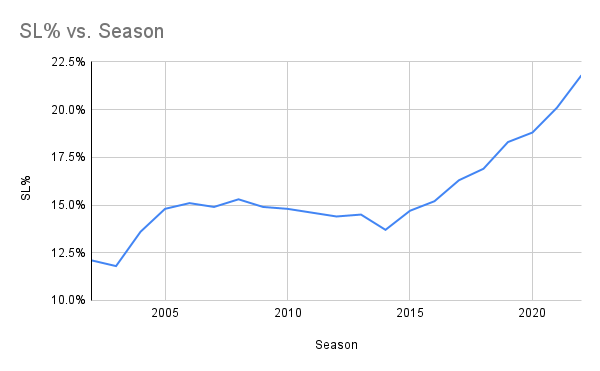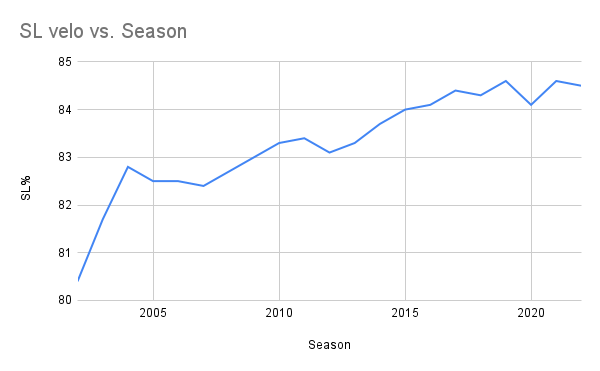Around this time last year Lindsey Adley, formerly of The Athletic, published a piece about the “whirly” — a new type of slider the Yankees’ pitching staff was embracing. This came roughly 6 months after Eno Sarris’ article “Is there a such a thing as a Dodgers slider?”
Over the past year so many more organizations, and so many individual players, have embraced the sweeper/whirly that reading those aforementioned pieces feels archaic, as if I’m re-reading Moneyball in 2023.
The pitch’s popularity caught on like wildfire, and it’s suddenly a part of our vernacular in a way reminiscent of how quickly we adopted the terms launch angle and spin rates.
So far this spring I’ve read stories about Zack Wheeler, Jeffrey Springs, Joe Ryan, Michael Fulmer, and many more adopting the pitch. It’s the type of slider Shohei Ohtani threw to Mike Trout to end the WBC:
Baseball Savant recently added the sweeper to their pitch classification system, even retroactively updating the designation for players like Yu Darvish, Drew Rasmussen, Evan Phillips, Collin McHugh, Paul Sewald, and many more.
I play in a reliever-only fantasy league (super cool, I know) and the mere idea of the sweeper was so new and tantalizing to me last spring that I named my team after it, having loaded up on Yankee/Dodger RPs. We’ve come a long way since then, so let’s talk about what the sweeper actually is, why it works, and where things are eventually heading with it.
The Sweeper’s Origins
First, a disclaimer that I am the furthest thing from an expert on pitch design. I merely keep an ear to the ground when it comes to high-level baseball analysis and I talk with coaches/scouts now and then. My goal here is to help bridge the gap from what’s actually happening inside MLB to those who might be learning more about sweepers for the first time.
Anyways, the sweeper has been around for a long time, though we don’t have pitch classification systems dating back too far. Some guy named Corey Kluber was using them to win Cy Young awards in the mid 2010s. He still throws it now, but Savant strangely didn’t give him the retroactive designation. Here’s what it looks like:
Adam Ottavino is another (known) early adopter of the pitch. Here’s what his looks like — a literal frisbee:
So it isn’t as if this is a brand new pitch baseball is suddenly “inventing” out of thin air. The biggest reason the sweeper has caught on is because teams now have the ability to track pitch design in real time through the use of high-speed rapsodo cameras and other top-notch tech.
A pitcher can be throwing a bullpen while a coach instantly analyzes the data coming through. The coach can see the velocity, the horizontal movement, the vertical movement, and more. From there, the coach can give the player tips, or cues, to achieve a more optimal movement profile. I recently spoke with a coach from Driveline who said he’s seen a pitcher learn a filthy, brand new slider within minutes.
What’s cool is that it isn’t just MLB teams who are doing this. Outside training facilities, such as Driveline and Tread Athletics, are working with professional (and amateur) players independently. Here’s a really cool video from Tread’s YouTube page showcasing how the pitch design process works:
Okay, So What Does the Sweeper Do?
I think the simplest way to describe the sweeper is that it’s a horizontal slider. During the Juiced Ball Era, from roughly 2015-21, baseball became a lot more “vertical.” Pitchers were attacking hitters with high-spin fastballs at the top of the zone, and they were pairing them with sharp-breaking “gyro” sliders. Think of apex Gerrit Cole.
Seriously, this is vicious:
Everything in baseball is cyclical, though. For a long while sinkers were in vogue, which is why hitters began trying to lift the ball more often (think launch angle). Pitchers counted with the aforementioned high-spin fastballs, and the “bullet slider” was a natural variation off of it.
So, hitters adjusted again — kind of. And now with everyone in a batter’s box preparing for vertical pitches, teams like the Dodgers and Yankees realized they could start attacking horizontally. This led to a ton of easy whiffs and popups.
Here’s a quote from Adler’s piece, linked above, on how the sweeper/whirly works:
“It’s often thrown with a two-seam grip, works the horizontal plane more than a typical slider does, and is developed to play off of true two-seam fastballs using a recently discovered scientific theory called seam-shifted wake.”
Here’s Yankee relief ace Michael King throwing it:
And here’s a good visualization, courtesy of Baseball Savant, of how the sweeper works when paired with other horizontal offerings (in King’s case, his sinker):
Imagine, as a right-handed hitter, preparing yourself for a pitch to arrive breaking horizontally away from you, and then all of a sudden you realize it’s a sinker coming in on your hands or knees? Yeah, hitting is hard nowadays.
Should Everyone Throw A Sweeper?
The short answer is no, but what I love about the sweeper’s story is that it has given another path for players who previously didn’t have an elite pitch mix.
Let’s say you’ve always had good “run”, meaning you’ve found success with sinkers/two-seamers/changeups, but without a pitch to truly play off of those it was likely a struggle to find sustained success. You might’ve experimented with high-spin fastballs and gyro sliders to play to the current trends, but not everyone is able to easily throw a high-90s fastball with a mid-80s bullet slider.
The sweeper changed that. Consider Clay Holmes, who always had a sinker but tried living the traditional slider life and was only so-so in the bigs. He then worked with both Tread and the Yankees, and suddenly his horizontal slider movement did this:
And now he’s one of the best relievers in baseball.
So no, not everyone needs to throw a sweeper, and not everyone should. It depends how it plays with the rest of your arsenal. Vertical pitchers have more success with gyro sliders and bullet spin. East-west pitchers have success with sweepers. It’s also important to understand your velocity because if someone is currently throwing a gyro slider at low velo, then they’re not going to be able to sweep it at high velo.
What’s Next?
Of course, that doesn’t mean pro athletes aren’t going to try and have the best of both worlds, not after all the success sliders have had in recent years. Here are a couple of charts, courtesy of Sports Info Solutions via Fangraphs, in regards to the amount of sliders thrown over the past 20 years, and the velo:
Sliders are being thrown more often, and they’re coming in harder. It’s a slider league right now, as the great Eno Sarris has been known to say. Are pitchers ready to try and master both the gyro and the sweeper?
Some already are, such as Mariners pitching prospect Bryce Miller.
We’re also already seeing pitchers “play off of” the sweeper. Matt Brash and Clarke Schmidt are two young arms who reverse engineered the process, having arrived to the majors with elite sweepers/breaking balls, but without anything to complement it, so they struggled.
Brash went to Driveline this offseason to develop a cutter — something he can throw more accurately with a similar-ish movement profile as his breaker. Schmidt’s cutter has been the reason behind his hype as a fantasy breakout candidate.


Some within the game think this is the next big development in pitching — pairing a cutter with sweeping breakers.
What we know is that the game will keep evolving. Sweepers are hot right now, but they could eventually lose some of their effectiveness if every hitter gets used to seeing them so often. That’s what happened to sinkers roughly a decade ago, and now we see less of them.
What’s different about the sweeper revolution is the technology behind it. Eventually, these machines will give some really smart coaches enough data and evidence to come up with “the next sweeper”, but that’s probably still a bit away.
For now, we’ll just leave it at the sweeper. I think it’s special, and I expect it to become the pitch of 2023.








